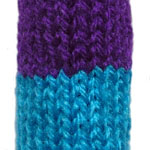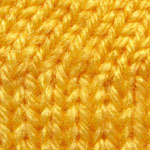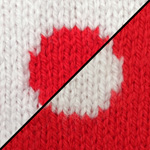Irregular Double Knitting
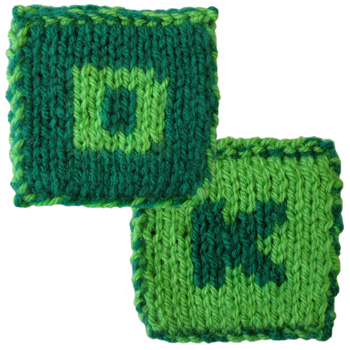
The basic double knitting technique produces a double thick fabric with symmetrical images on front and back. In irregular double knitting you knit different images on each side of the fabric. It's especially good if you want to incorporate words or asymmetrical symbols into your knitting.
You will need:
- yarn leftovers
- 2 x knitting needles
Technique
An irregular double knit fabric is built up by interspersing areas of double knitting with areas of rib stitching and, like regular double knitting, it's not nearly as bad as it sounds. This section builds directly on the techniques for double knitting, so if you need a quick review, go there first.
There are three sections on this page. 'Double Knit Stitches' describes the four basic stitch units you will need. 'Working a Grid' describes how to work through a chart. Finally 'Setting up a Grid' describes how to blend two regular knitting charts together to come up with your own irregular double knitting grid.
Double Knit Stitches
All double knit stitches are worked on two loops of knitting.
In a regular double knit stitch you hold both strands of yarn at the back, knit the first stitch in one colour, bring both strands of yarn forward, and purl the second stitch in the second colour.
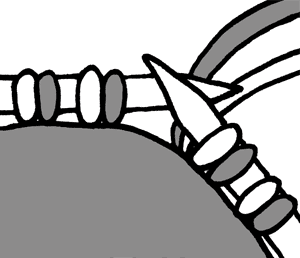
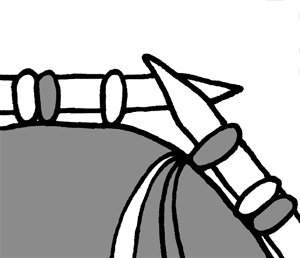
In an irregular double knit stitch you hold both strands of yarn at the back, knit the first stitch in one colour, bring both strands of yarn forward, and purl the second stitch in the same colour.
Note that you carry both strands of yarn across the knitting at all times. The irregular double knit stitch is therefore a single repeat of 1x1 rib, with a second colour of yarn woven between stitches to hide the float.
The four different types of stitches possible are all worked in exactly the same way, only the order in which the yarns are used varies. The only possible choices are:
- colour 1 then colour 2
- colour 2 then colour 1
- colour 1 then colour 1
- colour 2 then colour 2
Working a Grid
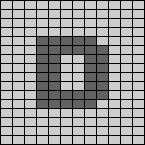
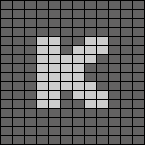
These are regular double knitting grids. You have light cells that are worked light stitch first on odd rows (and dark first on even). You also have dark cells that are worked dark first on odd rows (and light first on even).
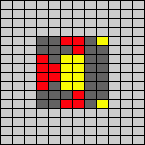
This is a grid chart for irregular double knitting. It combines the two regular charts shown above. The four different colours represent all the different types of double knitting stitches.
Yellow cells show you where to work both the first and second stitch in the light yarn. It doesn't matter if you are working odd or even rows.
Red cells show you where to work both the first and second stitch in the dark yarn.
Light and dark greys are worked exactly as you would for regular double knitting.
Setting up a Grid
Blend two knitting charts into one irregular double knitting chart by performing a half-dozen simple steps. All you need is an image editing programme that allows you to:
- fill bordered areas with a single colour
- flip images horizontally
- work with multiple layers in a single image
I use Photoshop Elements, but I believe there are multiple free programmes that allow you to do all these things.
Step 1
Take a transparent grid set up for stockinette stitch dimensions (like this one) and trim the image to the correct size for your knitting chart. Save three copies separately.
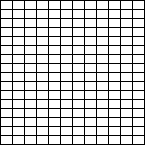


Step 2
On grids 1 and 2 draw out the patterns you want to combine by filling individual cells with colour. One of the patterns gets drawn in light grey, the other in dark grey. All non-pattern cells are left empty.

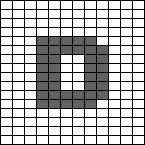
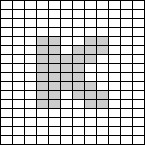
Step 3
Flip the light grey chart horizontally. That image is going on the reverse of the knitting.


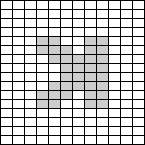
Step 4
Open the three grids as separate layers in the same document. Arrange them so the dark grey chart is on the bottom, the light grey chart is in the middle, and the blank grid is on top. Line up the grid lines as neatly as you can.

In the blank grid cover up any dark grey cells you can see with red.
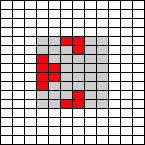
Step 5
Re-order the grey layers so that light grey is on the bottom, dark grey chart is in the middle.

In the formerly blank grid cover up any light grey cells you can see with yellow.
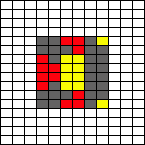
Step 6
Create a fourth layer underneath all the others. Fill it entirely with the light grey colour.

Flatten the image and save. This is your irregular double knitting chart.
<<< Back to Notes
© 2016 All desgins and images are copyright of ODDknit.
